Analysis of Proximity Consequences of Coil Windings in Electromagnetic Forming
Abstract
1. Introduction
1.1. Context of the Research
1.2. Tool Life and Geometries of Electromagnetic Forming Coils
1.3. Skin and Proximity Effects between Conductors
1.4. Purpose of the Study
- To develop and experimentally verify a numerical model to investigate the forming of the workpiece for various coil proximities and input energies;
- To evaluate the coil deformation for various discharge energies, cross-sections, and numbers of coils, so that this can be avoided in prospective applications.
2. Materials and Methods
2.1. Numerical Modeling in LS-DYNA
2.1.1. Development of the Simulation
2.1.2. Material Models and Data
2.2. Numerical Modeling in FEMM
Development of the Simulation
2.3. Experimental Analysis
2.3.1. Experimental Setup
2.3.2. Parameters Studied in the Experiments
2.3.3. Measurement Methods
3. Results
3.1. Validation of the Numerical Model
3.1.1. Comparison of Plastic Strains
3.1.2. Comparison of Midpoint Velocity
3.1.3. Comparison of the FEMM and LS-DYNA Model
3.2. Deformation of the Coils
3.2.1. Coil Deformation for Various Discharge Energies
3.2.2. Coil Deformation for Various Cross-Sections
4. Discussion
4.1. Deformation of the Sheet
4.1.1. Variation of Displacement, Midpoint Velocity and Efficiency of the Process with Coil Spacing
4.1.2. Change of Local Curvature with Coil Proximity
4.2. Deformation of the Coils
4.2.1. Numerical Prediction of Force between Two Coils
- No displacement of the coils and workpiece: As the force is applied, the coils begin to displace first elastically and then plastically towards one another. As the spacing between the coils is changed, it has an effect on the force as well, which will be higher than the predicted value. However, the displacement of the coils must start after a significant portion of the current is already discharged and must happen mostly due to inertia. Furthermore, according to Beerwald [26], most of the energy is transferred in the first two large pressure pulses of the current, until which, not much displacement of the coil is expected.
- An assumption about discharge current: FEMM can only model the discharge of a constant amplitude sinusoidal current, while the real current is damped in nature. Therefore, FEMM is used only for the calculation of the maximum force between the two coils, which would happen at the maximum value of current flowing between the two coils.
4.2.2. Measures to Avoid Coil Deformation
- Changing the coil cross-section: Increasing the coil cross-section leads to lower deformations due to increased coil rigidity. However, the increase in dimensions of the cross-section leads to a lower current density and smaller workpiece deformation. Furthermore, if the width of the coil is increased to protect against the deformation due to the attractive force from the other coils, this will not provide much benefit against the reaction force exerted by the coil, which is orthogonal to the former force and about four times the magnitude in the geometry used in this study. It also increases the material used for the coils.
- Providing insulation support: In some of the experiments, the coils were separated by insulation made of glass-fiber-reinforced polymer, which has excellent compressive strength and insulating properties. In such experiments, the coil deformation due to the attractive force could be completely avoided. However, this led to a higher deformation in the orthogonal direction (the direction where the coil deformed due to the reaction force from the workpiece). With a good insulation design, the deformation of the coil can be completely avoided. Before implementation, however, the damping characteristics of the polymer must also be investigated.
- Innovative coil design: Gies [27] proposed using hybrid conductors for the reduction of coil deformation and suggested the methodology for the design as well. With the appropriate design of the steel support, plastic deformation of the coil can be avoided for some discharge energies. Other ideas for an improvement of the coil design could be the addition of cooling possibilities in the coil so that thermal softening of the material is prevented.
5. Conclusions
Author Contributions
Funding
Data Availability Statement
Conflicts of Interest
References
- Psyk, V.; Risch, D.; Kinsey, B.L.; Tekkaya, A.E.; Kleiner, M. Electromagnetic forming—A review. J. Mater. Process. Technol. 2011, 211, 787–829. [Google Scholar] [CrossRef]
- Ahmed, M.; Panthi, S.K.; Ramakrishnan, N.; Jha, A.K.; Yegneswaran, A.H.; Dasgupta, R.; Ahmed, S. Alternative flat coil design for electromagnetic forming using FEM. Trans. Nonferrous Met. Soc. China 2010, 21, 618–625. [Google Scholar] [CrossRef]
- Demir, O.K.; Goyal, S.P.; Hahn, M.; Tekkaya, A.E. Novel Approach and Interpretation for the Determination of Electromagnetic Forming Limits. Materials 2020, 13, 4175. [Google Scholar] [CrossRef] [PubMed]
- Thibaudeau, E.; Kinsey, B.L. Analytical design and experimental validation of uniform pressure actuator for electromagnetic forming and welding. J. Mater. Process. Technol. 2015, 215, 251–263. [Google Scholar] [CrossRef]
- Gayakwad, D.; Dargar, M.K.; Sharma, P.K.; Purohit, R.; Rana, R.S. A Review on Electromagnetic Forming Process. Procedia Mater. Sci. 2014, 6, 520–527. [Google Scholar] [CrossRef]
- Takatsu, N.; Kato, M.; Sato, K.; Tobe, T. High-Speed Forming of Metal Sheets by Electromagnetic Force. JSME Int. J. 1988, 31, 142–148. [Google Scholar] [CrossRef]
- Gies, S.; Tekkaya, A.E. Effect of workpiece deformation on Joule heat losses in electromagnetic forming coils. Procedia Eng. 2017, 207, 347–346. [Google Scholar] [CrossRef]
- Golovashchenko, S.F. Material Formability and Coil Design in Electromagnetic Forming. J. Mater. Eng. Perform. 2007, 16, 314–320. [Google Scholar] [CrossRef]
- Taebi, F.; Demir, O.K.; Stiemer, M.; Psyk, V.; Kwiatkowski, L.; Brosius, A.; Blum, H.; Tekkaya, A.E. Dynamic forming limits and numerical optimization of combined quasi-static and impulse metal forming. Comput. Mater. Sci. 2012, 54, 293–302. [Google Scholar] [CrossRef]
- Watanabe, M.; Kumai, S. High-Speed Deformation and Collision Behavior of Pure Aluminum Plates in Magnetic Pulse Welding. Mater. Trans. 2009, 50, 2035–2042. [Google Scholar] [CrossRef]
- Dwight, H.B. Skin effect in tubular and flat conductors. Trans. Am. Inst. Electr. Eng. 1918, XXXVII-2, 1379–1403. [Google Scholar] [CrossRef]
- Kennelly, A.E.; Laws, F.; Pierce, P. Experimental researches on skin effect in conductors. Trans. Am. Inst. Electr. Eng. 1915, 34, 1953–2021. [Google Scholar] [CrossRef]
- Reatti, A.; Grasso, F. Solid and Litz-wire winding non-linear resistance comparison. In Proceedings of the 43rd IEEE Midwest Symposium on Circuits and Systems (Cat.No.CH37144), Lansing, MI, USA, 8–11 August 2000; pp. 466–469. [Google Scholar]
- Sigg, H.J.; Strutt, M.J.O. Skin effect and proximity effect in polyphase systems of rectangular conductors calculated on an RC network. IEEE Trans. Power App. Syst. 1970, 89, 470–477. [Google Scholar] [CrossRef]
- Popovic, Z.; Popovic, B.D. Introductory Electromagnetics; Prentice Hall: Upper Saddle River, NJ, USA, 2000. [Google Scholar]
- Riba, J.R. Calculation of the ac to dc resistance ratio of conductive nonmagnetic straight conductors by applying FEM simulations. Eur. J. Phys. 2000, 36. [Google Scholar] [CrossRef][Green Version]
- Abdelbagi, H.E. Skin and Proximity Effects in Two Parallel Plates. 2007. Available online: https://corescholar.libraries.wright.edu/etd_all/18419 (accessed on 30 November 2020).
- Vitelli, M. Numerical evaluation of 2-D proximity effect conductor losses. IEEE Trans. Power Deliv. 2004, 19, 1291–1298. [Google Scholar] [CrossRef]
- L’Eplattenier, P.; Cook, G.; Ashcraft, C.; Burger, M.; Imbert, J.; Worswick, M. Introduction of an Electromagnetism Module in LS-DYNA for Coupled Mechanical-Thermal-Electromagnetic Simulations. Steel Res. Int. 2009, 80, 351–358. [Google Scholar] [CrossRef]
- Gies, S.; Tekkaya, A.E. Analytical prediction of Joule heat losses in electromagnetic forming coils. J. Mater. Process. Technol. 2017, 246, 102–115. [Google Scholar] [CrossRef]
- Liu, X.; Huang, L.; Su, H.; Ma, F.; Li, J. Comparative Research on the Rebound Effect in Direct Electromagnetic Forming and Indirect Electromagnetic Forming with an Elastic Medium. Materials 2018, 11, 1450. [Google Scholar] [CrossRef] [PubMed]
- Weddeling, C. Electromagnetic Form-Fit Joining. Ph.D. Dissertation, Universität Dortmund, Dortmund, Germany, 2014. [Google Scholar]
- Clausen, A.H.; Børvik, T.; Hopperstad, O.S.; Benallal, A. Flow and fracture characteristics of aluminium alloy AA5083–H116 as function of strain rate, temperature and triaxiality. Mater. Sci. Eng. A 2004, 364, 260–272. [Google Scholar] [CrossRef]
- Kabirian, F.; Khan, A.S.; Pandey, A. Negative to positive strain rate sensitivity in 5xxx series aluminum alloys: Experiment and constitutive modeling. Int. J. Plast. 2014, 55, 232–246. [Google Scholar] [CrossRef]
- Moro, E.A. New Developments in photon Doppler velocimetry. J. Phys. Conf. Ser. 2014, 500, 142023. [Google Scholar] [CrossRef]
- Beerwald, C. Grundlagen der Prozessauslegung und -Gestaltung Bei der Elektromagnetischen Umformung. Ph.D. Dissertation, Universität Dortmund, Dortmund, Germany, 2005. [Google Scholar]
- Gies, S.; Tekkaya, A.E. Design of Hybrid Conductors for Electromagnetic Forming Coils. In Proceedings of the 8th International Conference on High Speed Forming, Columbus, OH, USA, 14 May 2018. [Google Scholar] [CrossRef]
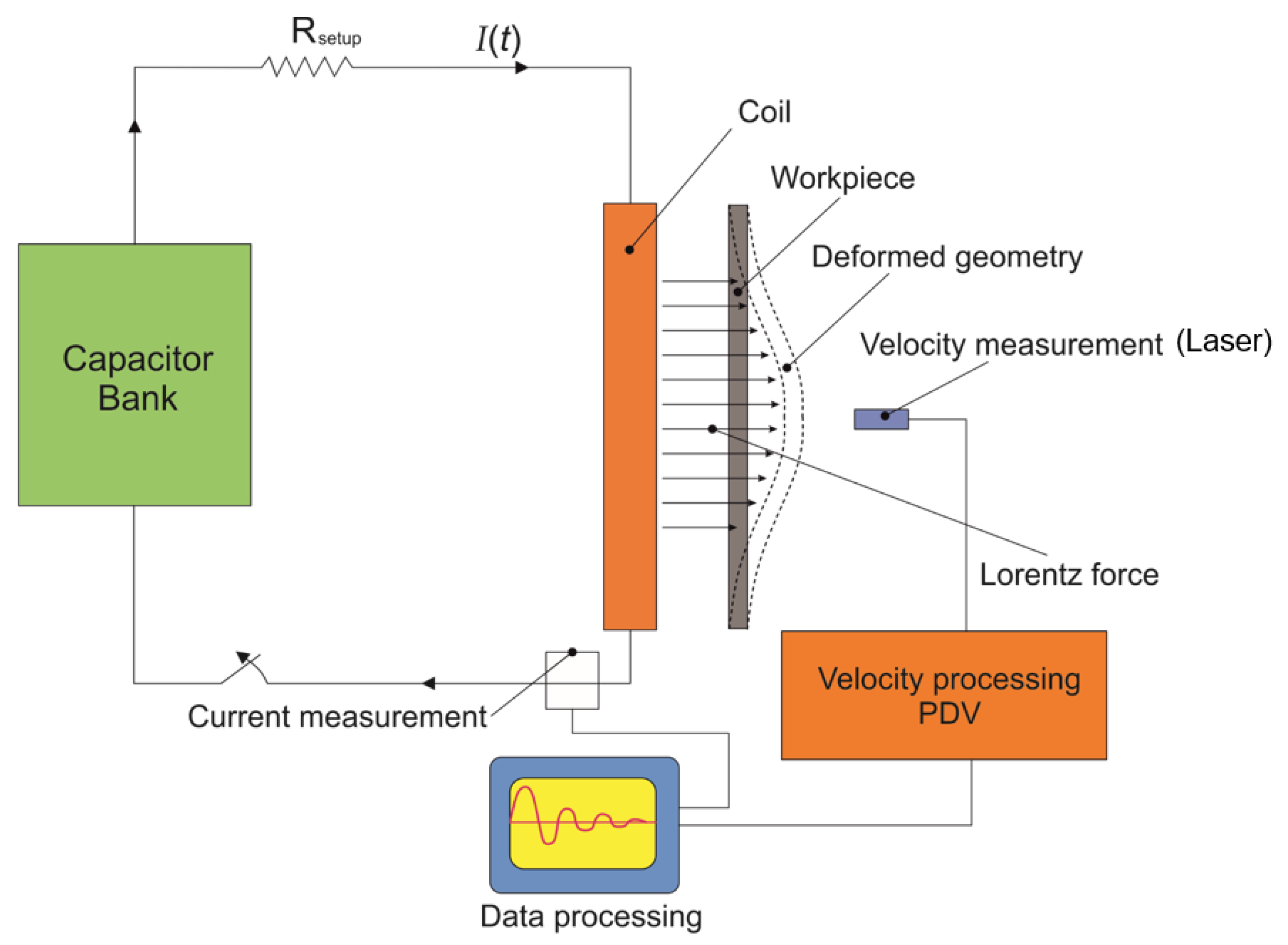
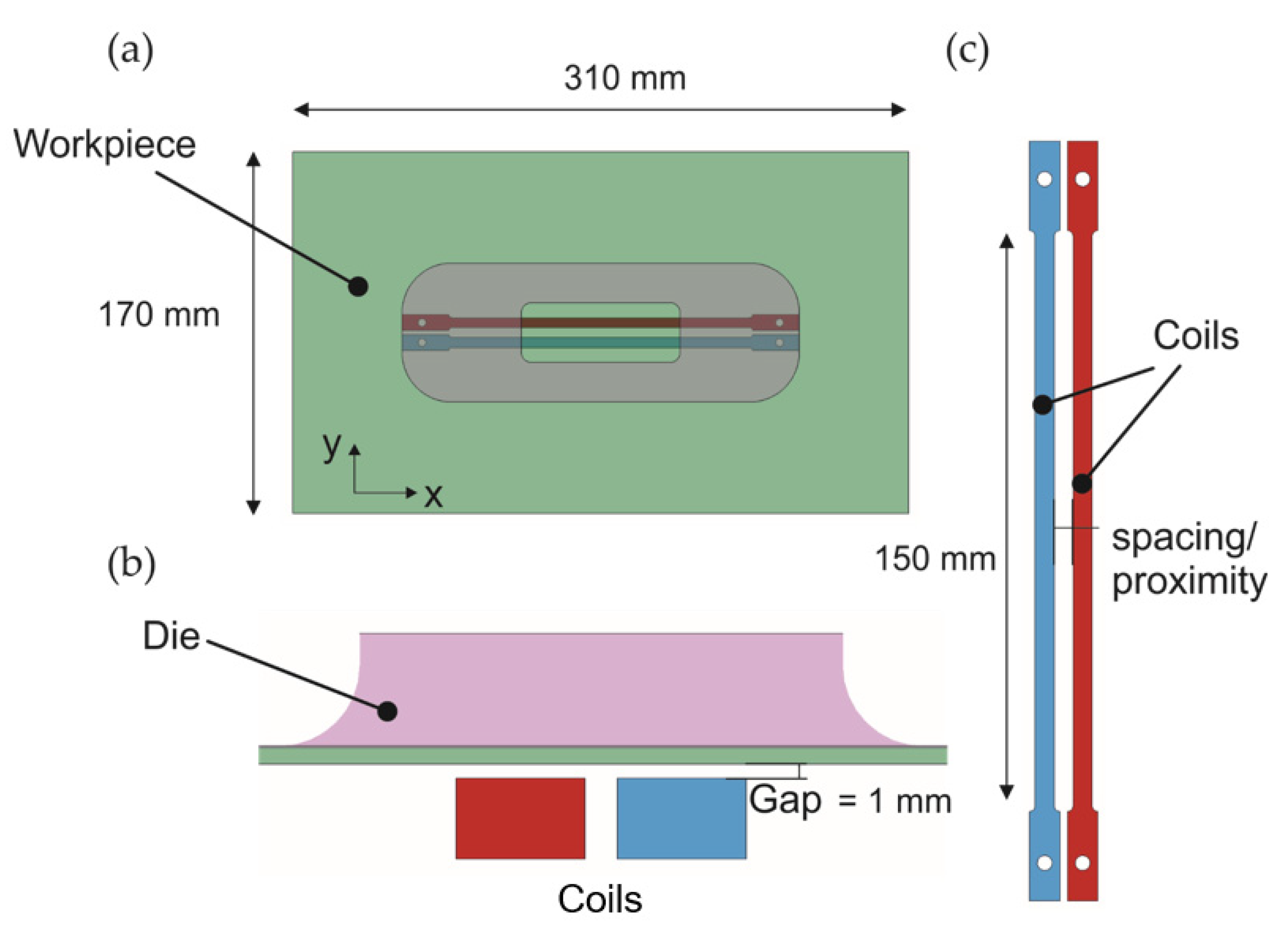



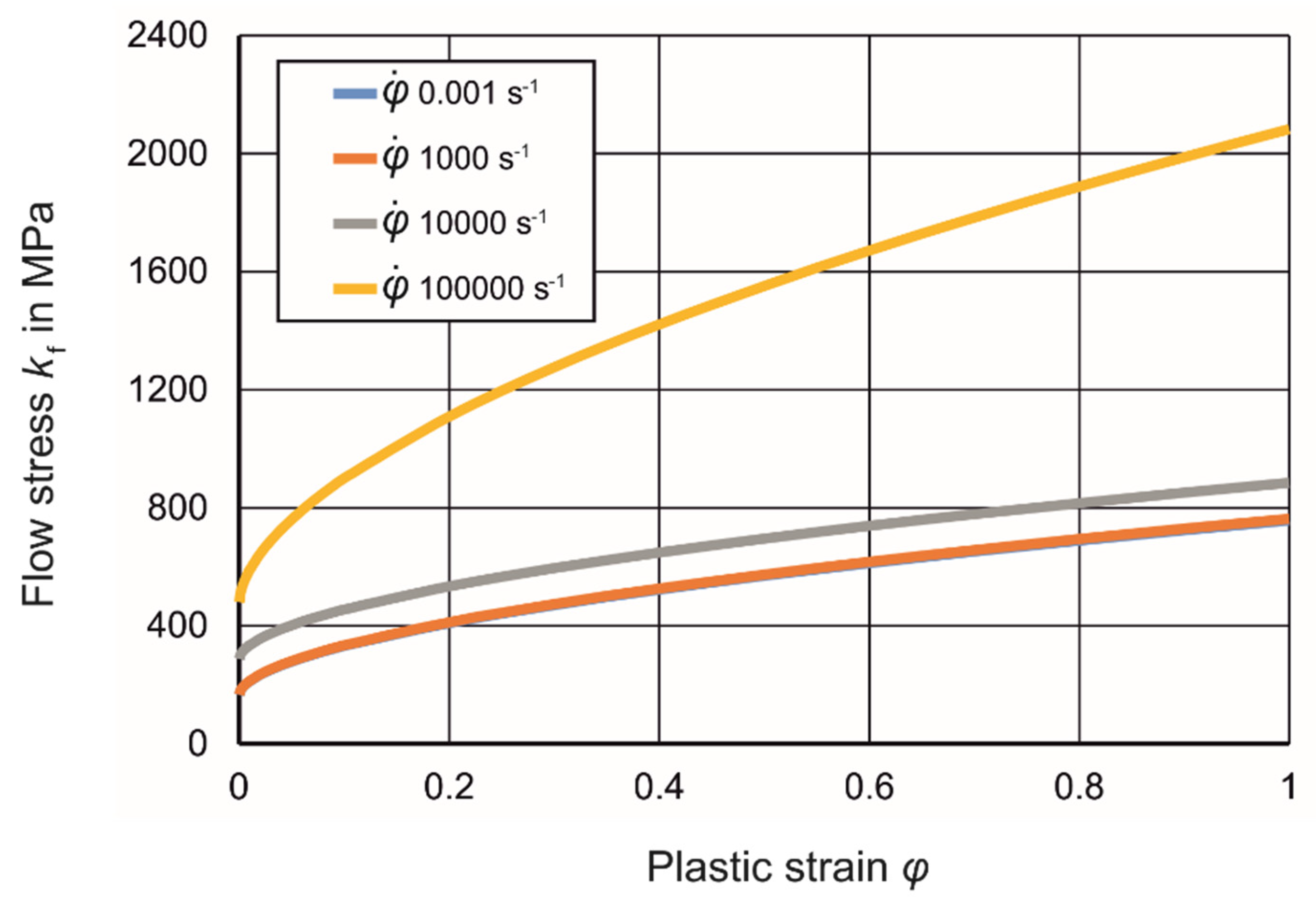
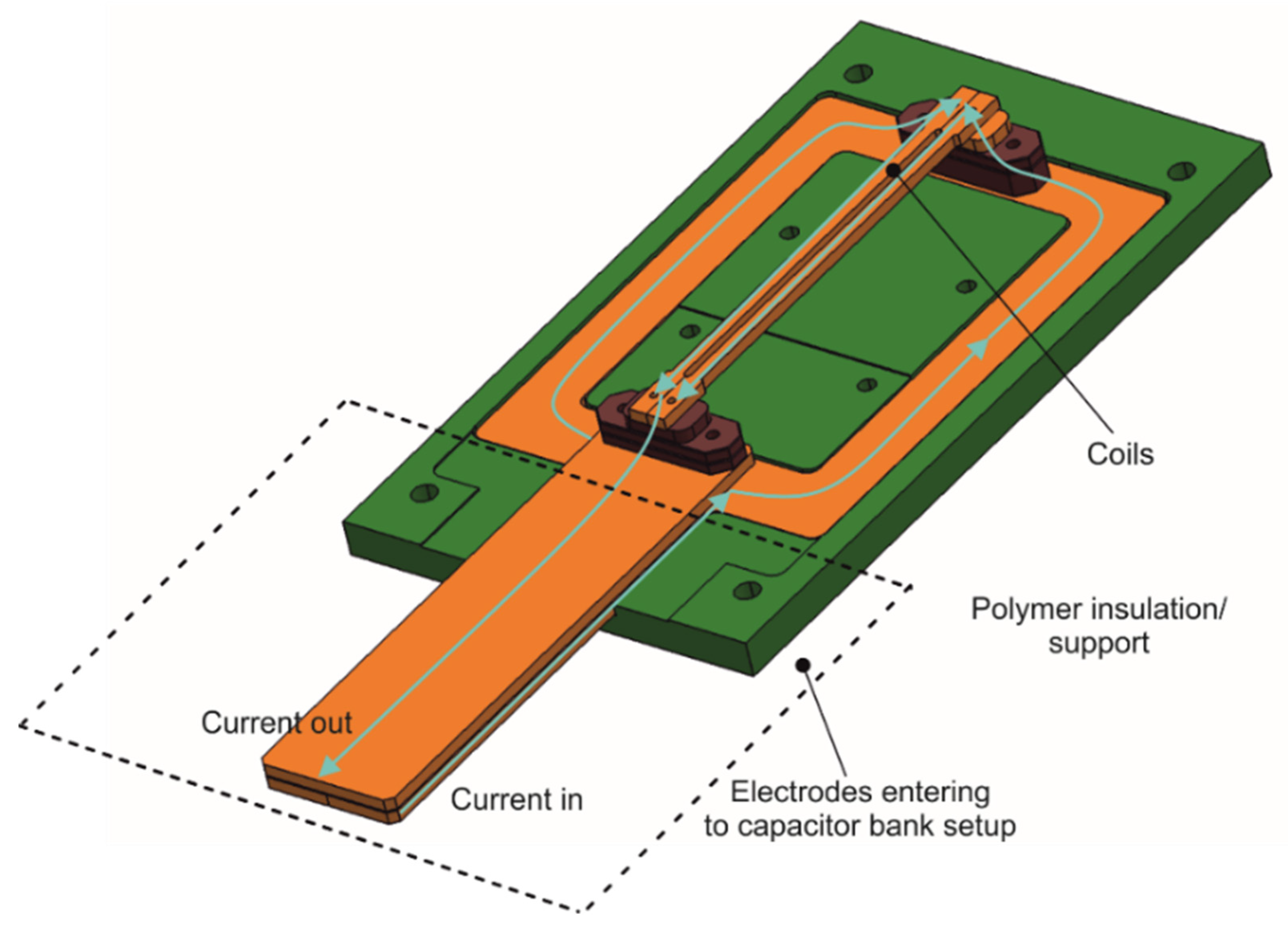

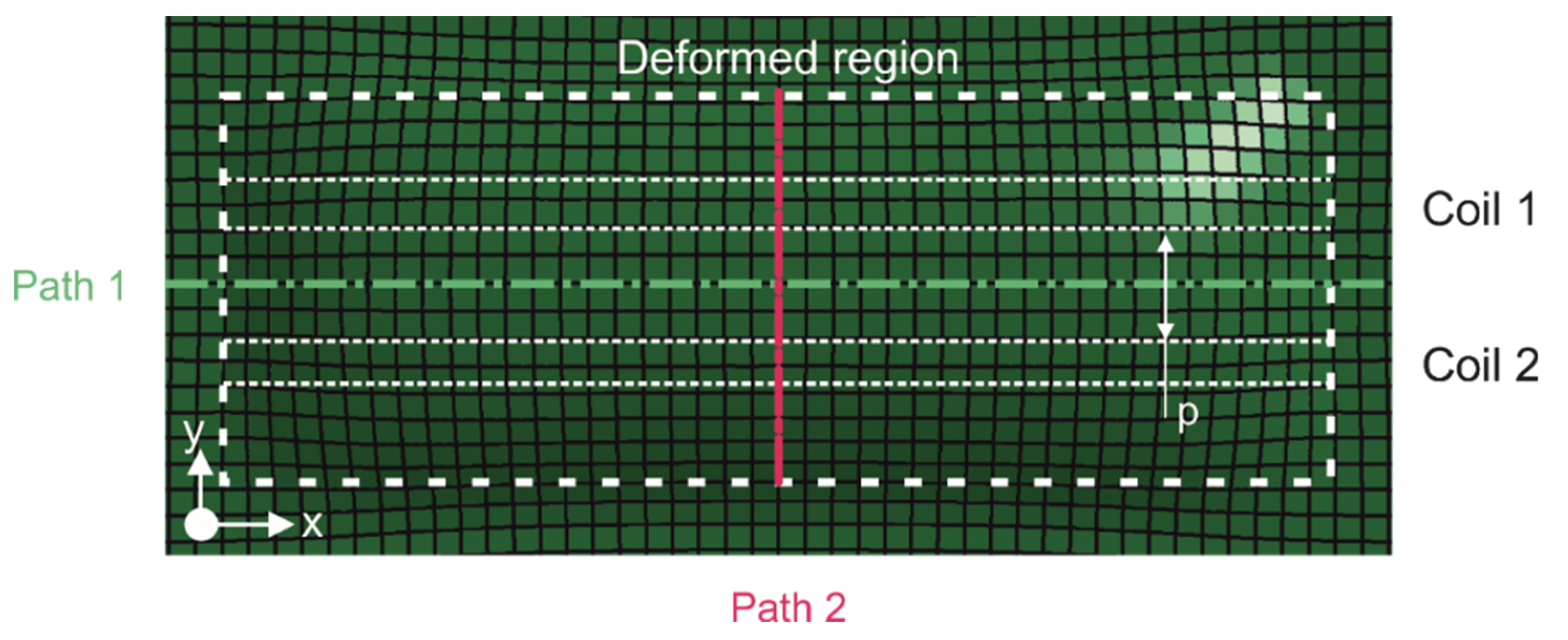
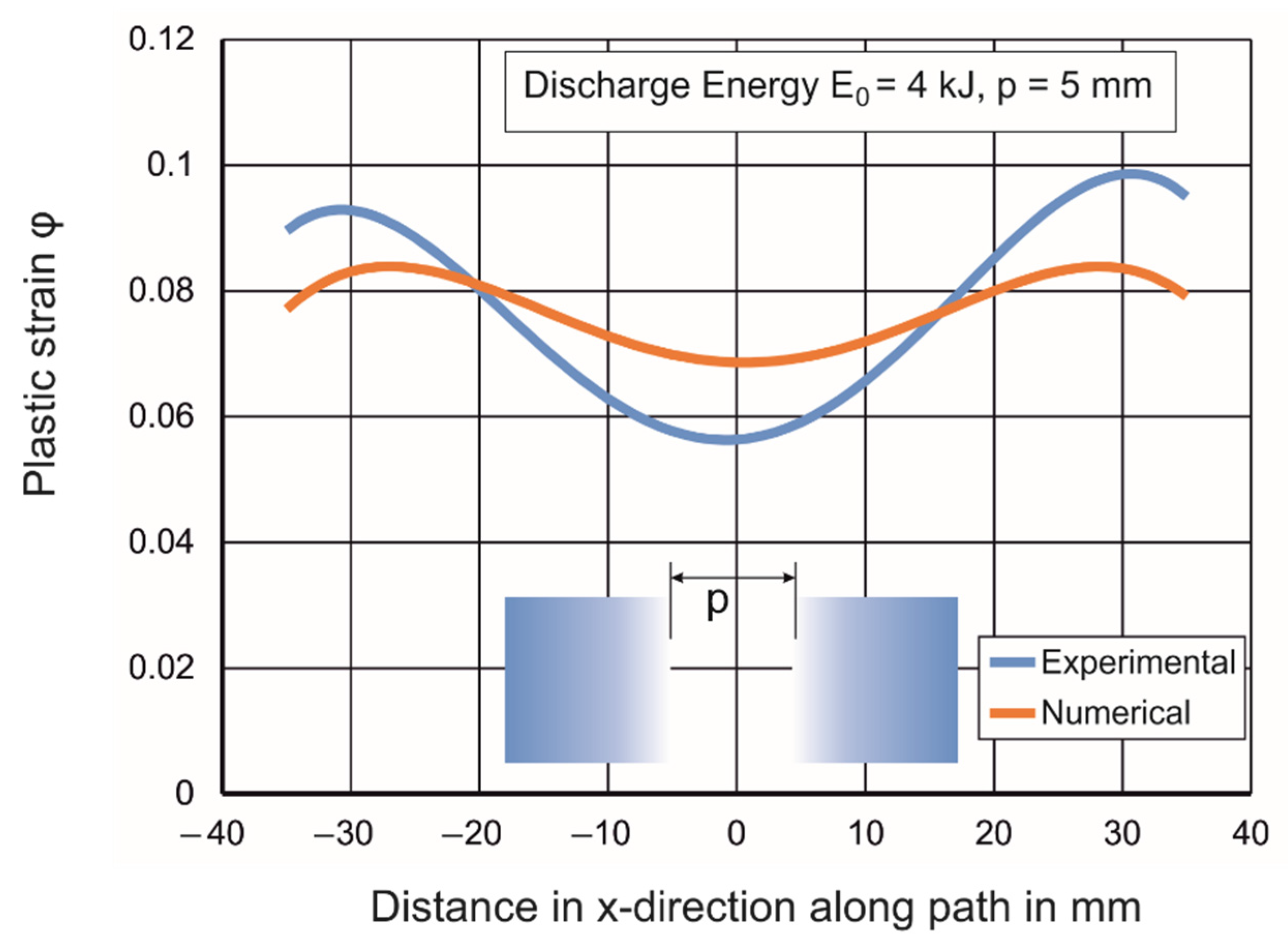

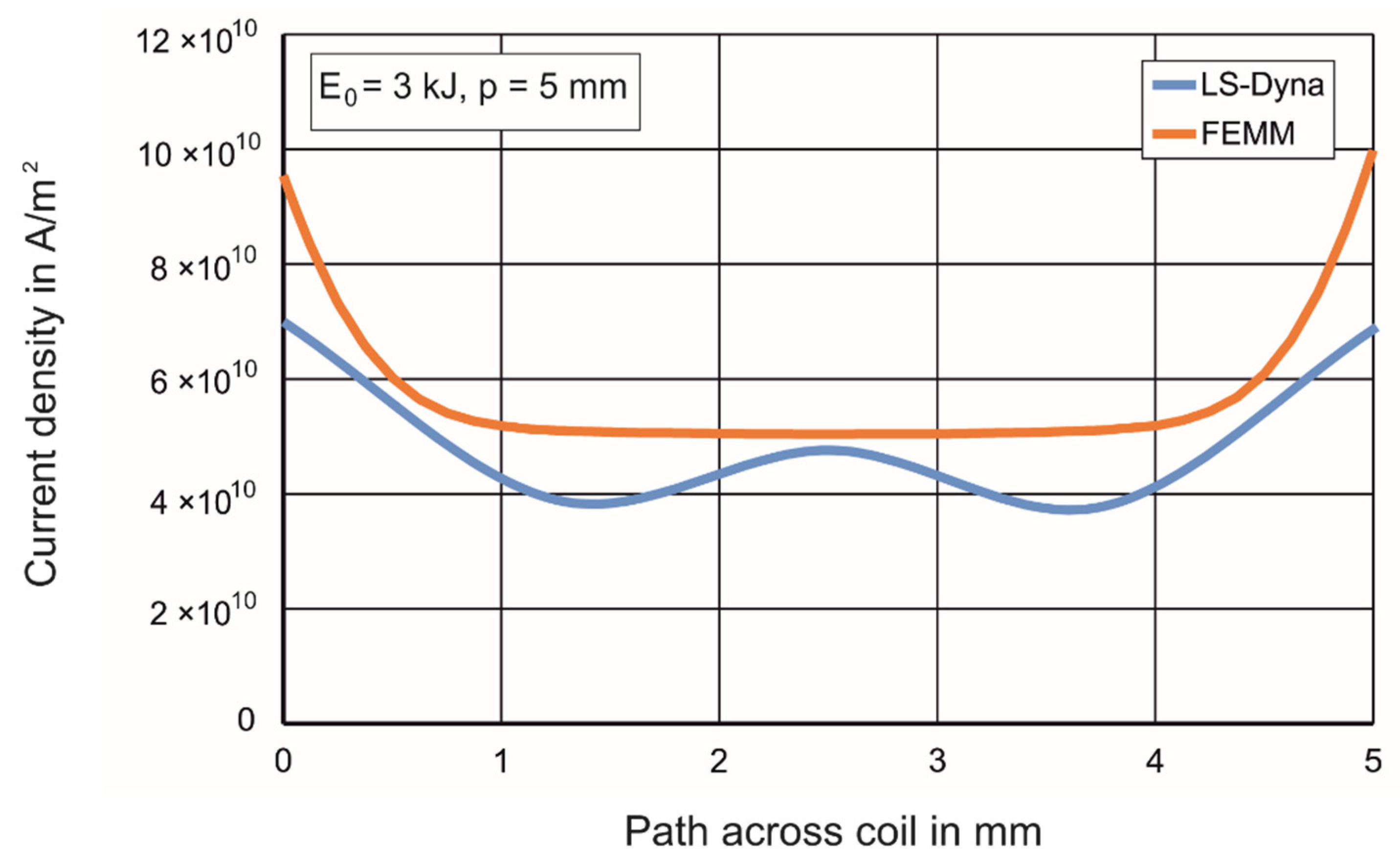
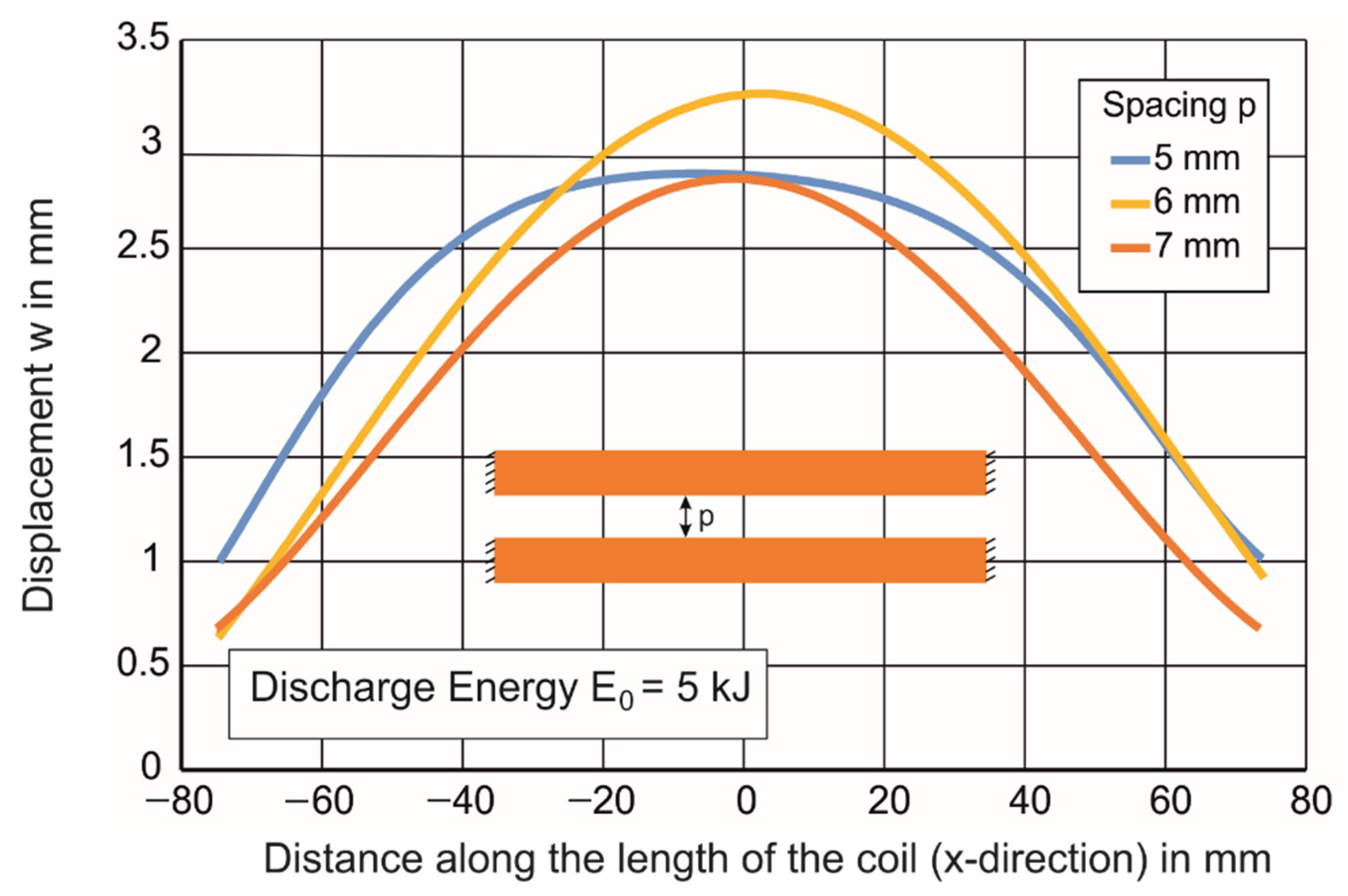
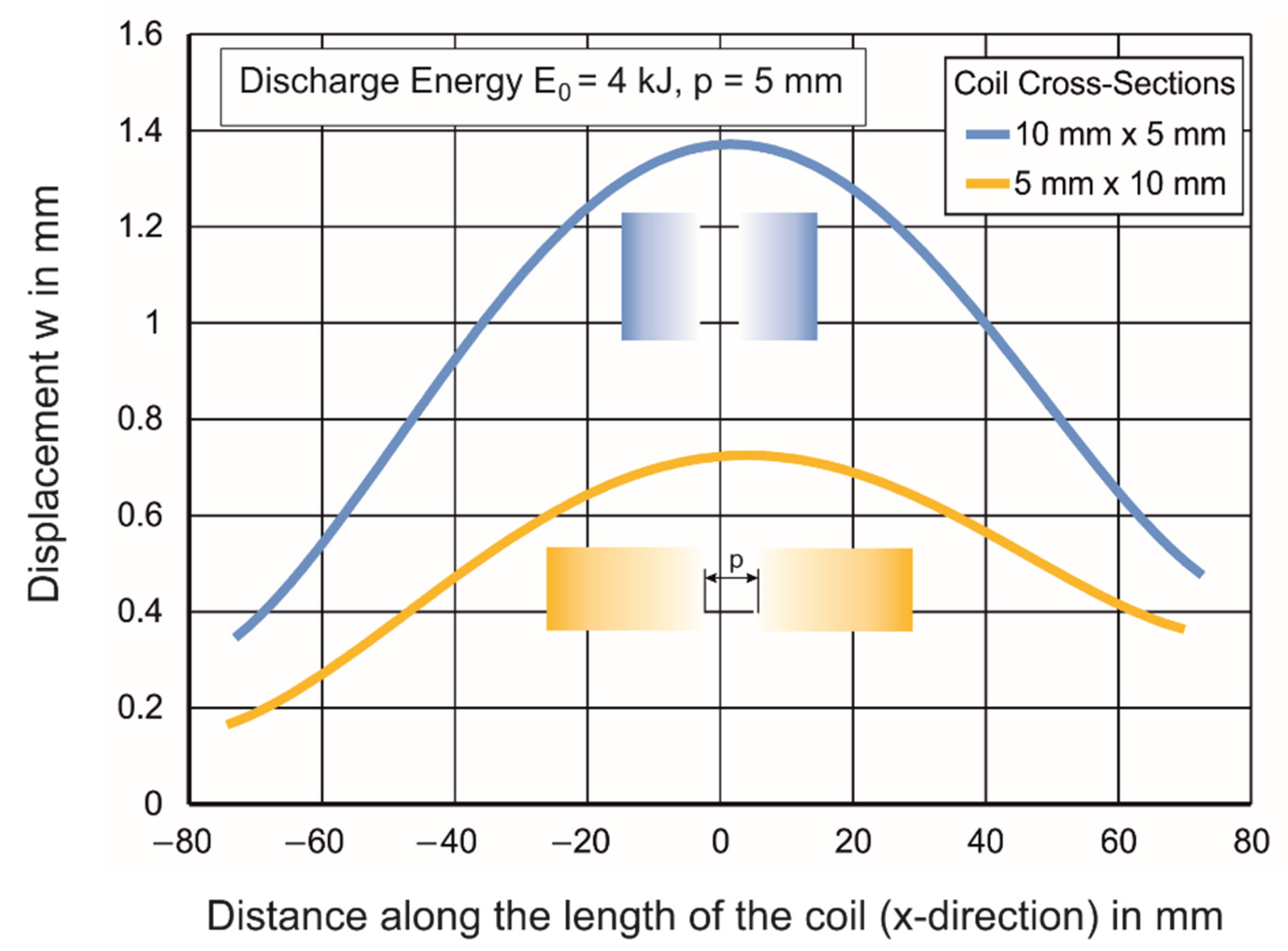
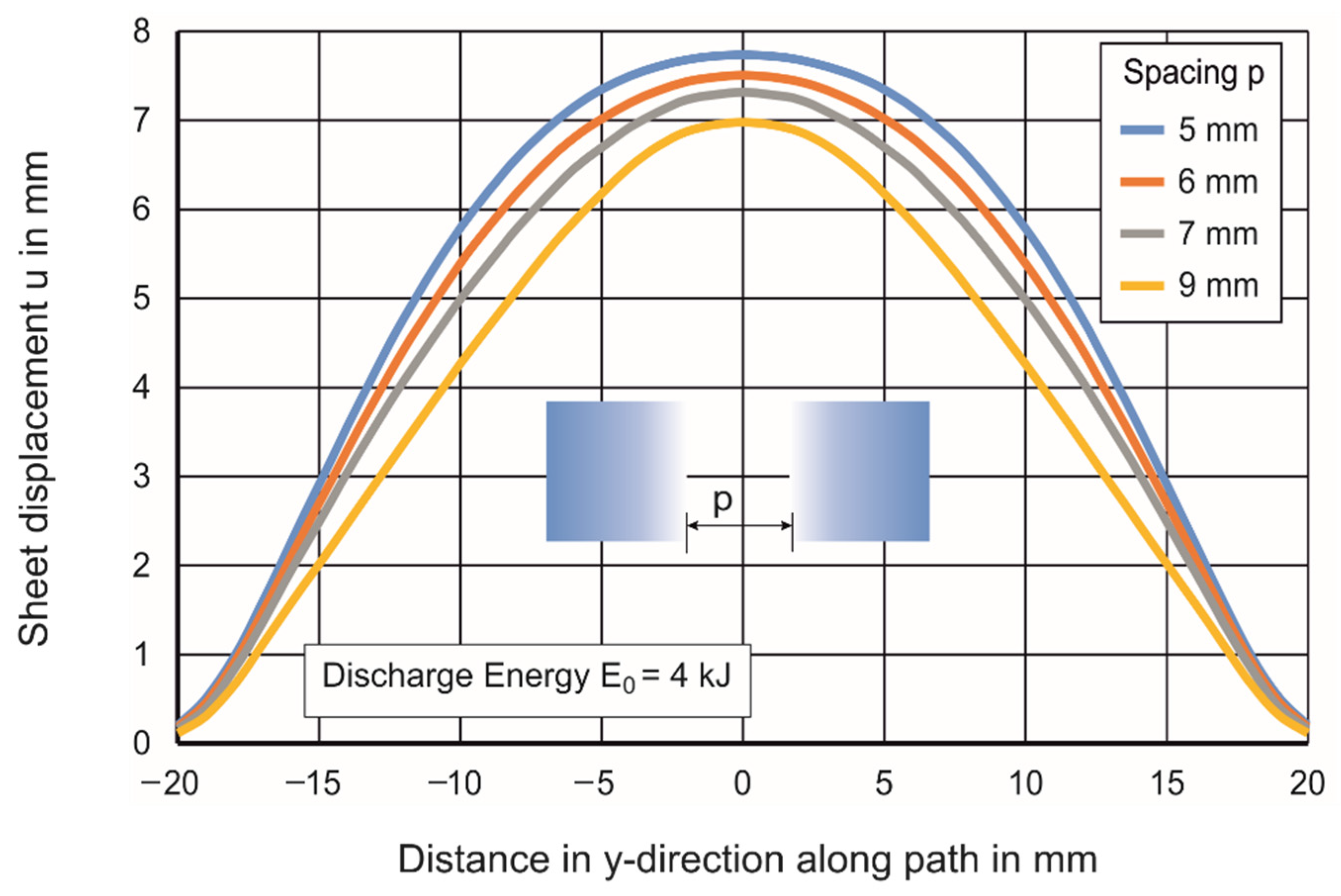

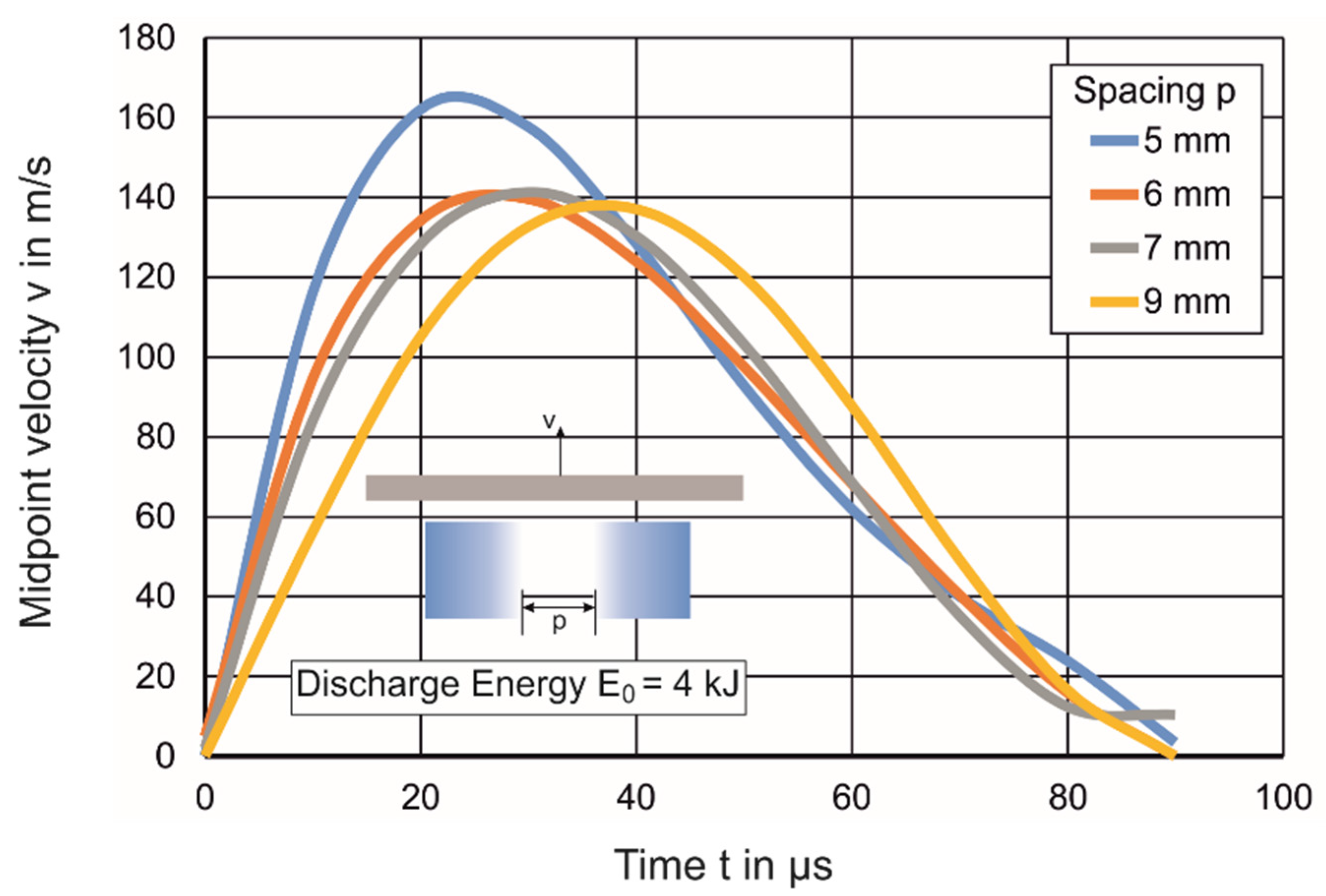
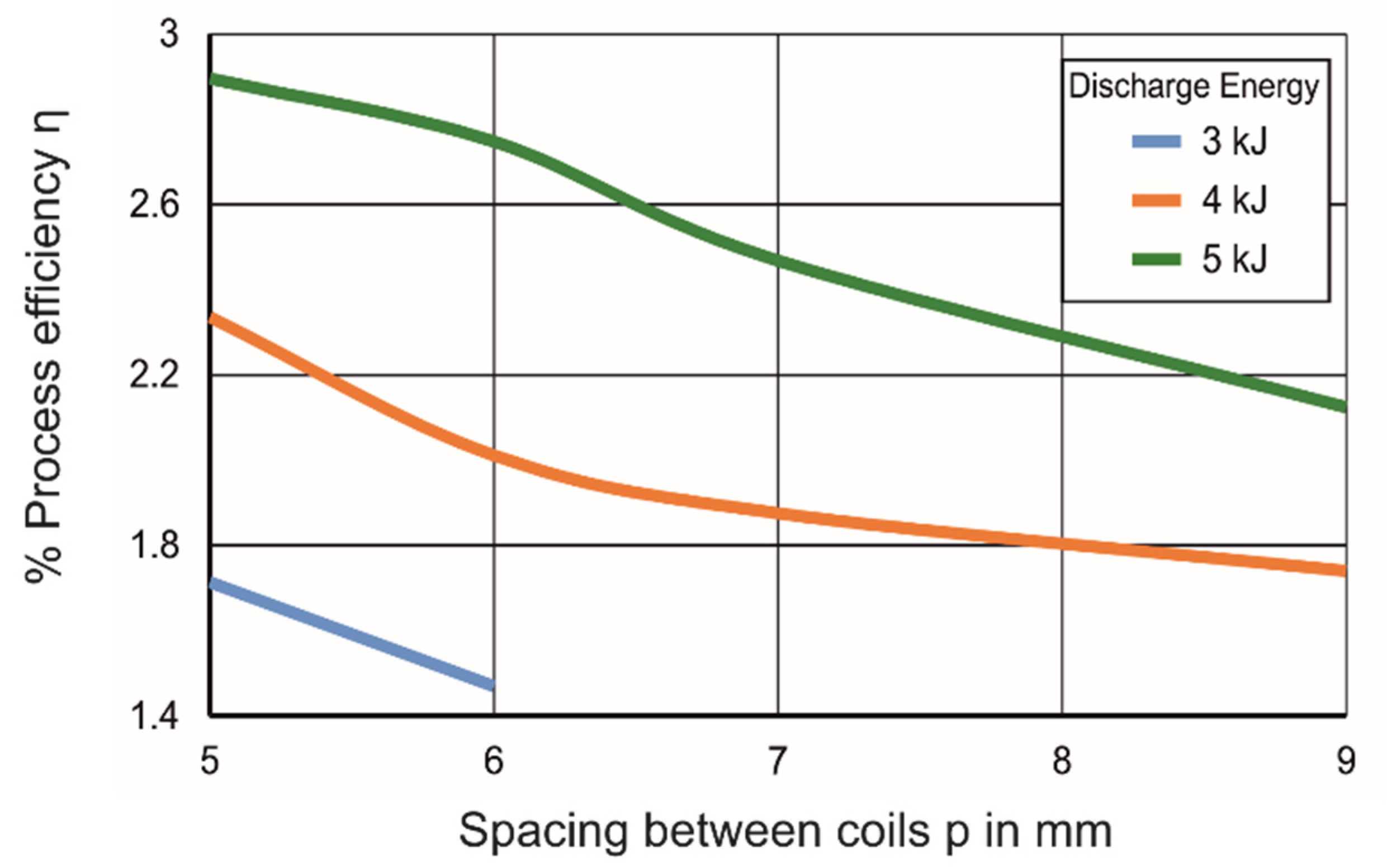
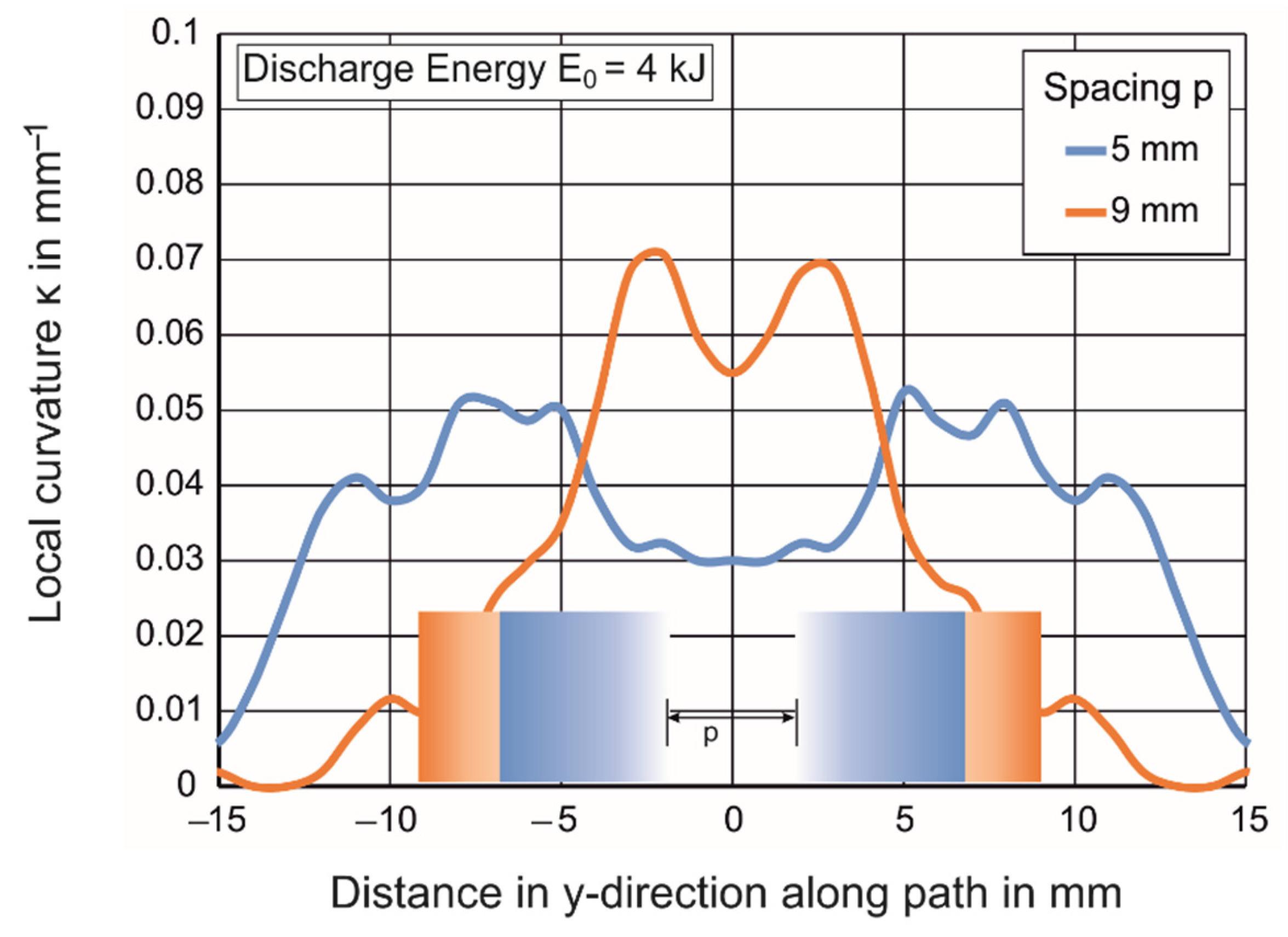
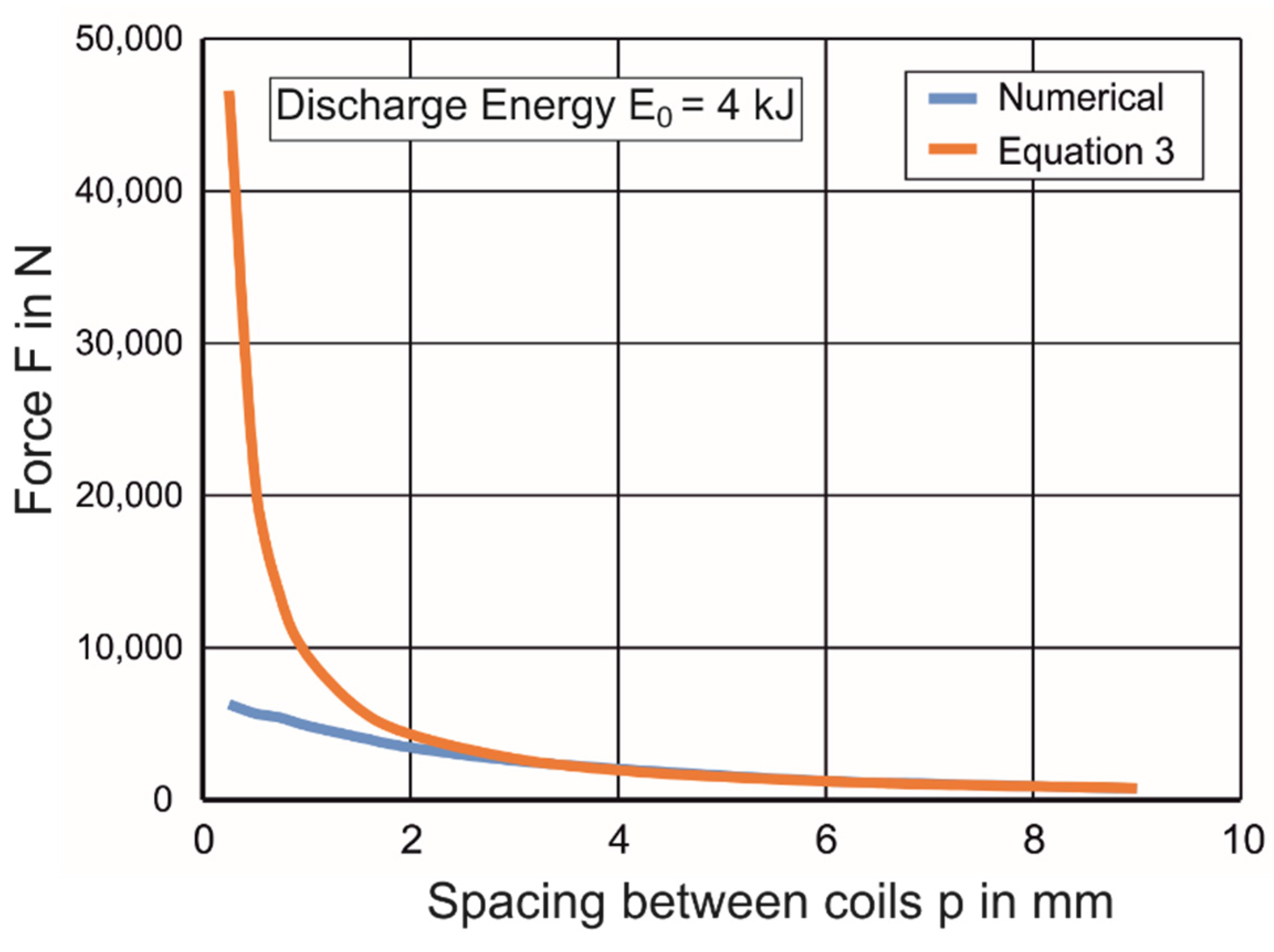
| Temperature (K) | CuCr1Zr (MS/m) | CuCr1Zr (W/mK) | CuCr1Zr | EN-AW 5083 (W/mK) | EN-AW 5083 |
|---|---|---|---|---|---|
| 298 | 52.0 | 343 | 385 | 126 | 899 |
| 350 | 44.8 | 347 | 392 | 133 | 919 |
| 399 | 39.7 | 350 | 397 | 138 | 939 |
| 448 | 35.3 | 350 | 401 | 143 | 959 |
| 498 | 31.6 | 348 | 405 | 149 | 979 |
| 548 | 28.8 | 349 | 408 | 155 | 999 |
| 598 | 26.2 | 347 | 410 | 159 | 1018 |
| 647 | 23.9 | 343 | 412 | 163 | 1038 |
| 698 | 21.9 | 339 | 414 | 164 | 1059 |
| 749 | 20.2 | 335 | 416 | 166 | 1079 |
| 774 | 19.5 | 334 | 418 | 167 | 1089 |
| Characteristic | Value |
|---|---|
| Max. discharge energy Emax | 9 kJ |
| Max. discharge voltage Umax | 15 kV |
| Capacitance C | 80 μF |
| Inductance L | 1093 nH |
| Discharge frequency f | ≈17 kHz |
Publisher’s Note: MDPI stays neutral with regard to jurisdictional claims in published maps and institutional affiliations. |
© 2021 by the authors. Licensee MDPI, Basel, Switzerland. This article is an open access article distributed under the terms and conditions of the Creative Commons Attribution (CC BY) license (https://creativecommons.org/licenses/by/4.0/).
Share and Cite
Goyal, S.P.; Lashkari, M.; Elsayed, A.; Hahn, M.; Tekkaya, A.E. Analysis of Proximity Consequences of Coil Windings in Electromagnetic Forming. J. Manuf. Mater. Process. 2021, 5, 45. https://doi.org/10.3390/jmmp5020045
Goyal SP, Lashkari M, Elsayed A, Hahn M, Tekkaya AE. Analysis of Proximity Consequences of Coil Windings in Electromagnetic Forming. Journal of Manufacturing and Materials Processing. 2021; 5(2):45. https://doi.org/10.3390/jmmp5020045
Chicago/Turabian StyleGoyal, Siddhant Prakash, Mohammadjavad Lashkari, Awab Elsayed, Marlon Hahn, and A. Erman Tekkaya. 2021. "Analysis of Proximity Consequences of Coil Windings in Electromagnetic Forming" Journal of Manufacturing and Materials Processing 5, no. 2: 45. https://doi.org/10.3390/jmmp5020045
APA StyleGoyal, S. P., Lashkari, M., Elsayed, A., Hahn, M., & Tekkaya, A. E. (2021). Analysis of Proximity Consequences of Coil Windings in Electromagnetic Forming. Journal of Manufacturing and Materials Processing, 5(2), 45. https://doi.org/10.3390/jmmp5020045






